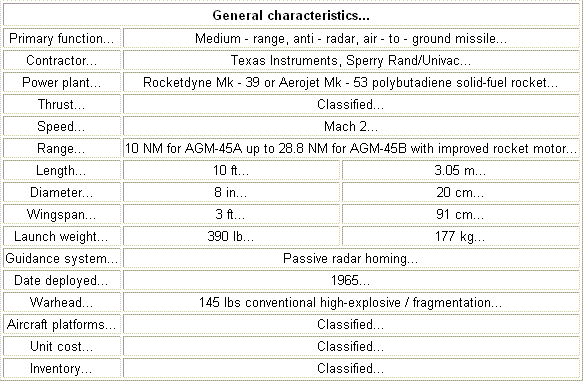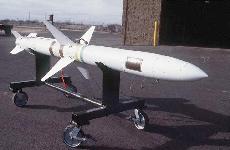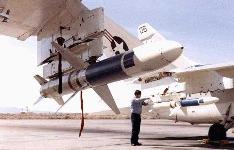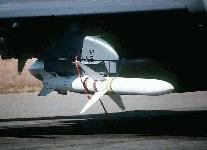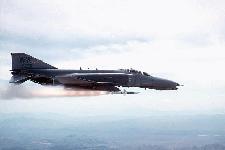
Info about the "Air to Ground" Missiles...
AGM - 45 Shrike...
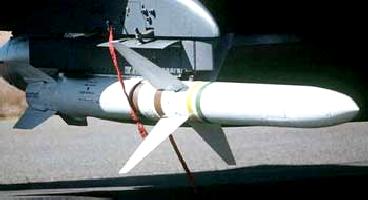
Background...
The AGM-45 SHRIKE series weapon system is a passive air-to-ground missile whose mission is to home on and destroy or
suppress radiating radar transmitters, directing both ground antiaircraft fire and surface-to-air missiles. The system
consists of an AGM-45 guided missile, AERO-5A/B or LAU-118 launcher, and a launch aircraft configured with SHRIKE-unique
avionics and a target identification acquisition system. The AGM-45 SHRIKE guided missile is composed of four major
sections; guidance, warhead, control, and rocket motor. Along with the wing and fin assemblies, the sections make up
the all-up-round missile. Several missile versions have been developed and produced to home on certain types of enemy
radar transmitters. Each version consists of a guidance section specially developed and tuned to a specific frequency
range unique to an individual threat radar. The AERO-5B-1 and LAU-118 series rail launchers are used to launch the SHRIKE
missile. They provide the electrical and mechanical interface between the SHRIKE guided missile and the launch aircraft.
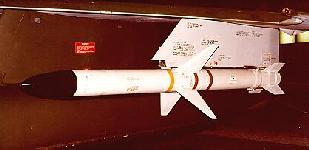
NOTS developed Shrike, the first successful antiradar missile, beginning in 1958 as a direct response to Fleet needs, and
China Lake personnel took the missile to the carriers in Southeast Asia in the 1960s. During the Vietnam War, aircraft
launched the first combat firing of the Shrike. Shrike was developed following many of the same principles that guided
Sidewinder development: simplicity, reliability, maintainability, producibility, improvability. The AGM-45 was the first
mass produced missile built specifically for the anti-radar mission, and more than 20,000 Shrikes were produced beginning
in 1962. The Shrike's effectiveness was limitated by the requirement that the missile be pointed at the intended target
radar during launch, and that the Shrike will lose its lock if the radar ceases to radiate. The Shrike is now being
replaced by the much improved AGM-88 HARM.
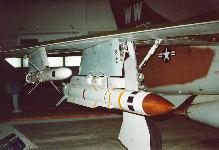
Development...
Development started at the US Naval Weapons Centre, China Lake in 1961, utilising the AIM-7 Sparrow aerodynamic shape and
some common assemblies, with the first missiles entering service in the mid-1960s. This first-generation anti-radar missile
had several improvement programmes, and has been in service with the USAF and USN as AGM-45A and -45B. The Shrike has been
cleared for carriage on F-105 Thunderchief, F-4 Phantom, F-16 Fighting Falcon, Kfir, A-4 Skyhawk, A-6 Intruder, A-7 Corsair
II and Vulcan B-2 aircraft.
Description...
AGM-45 Shrike has four moving delta-wings at mid-body and four fixed-rectangular fins with a swept leading-edge at the
rear. The missile is 3.05 m long, has a body diameter of 203 mm and a wingspan of 0.91 m. The missile weighs 177 kg and
has a 66 kg HE fragmentation warhead. Guidance is by passive radar homing and it is reported that there are 12 homing head
assemblies each tuned to different narrow wavebands. An improved control system, incorporated as AGM-45-9A, provides more
flexibility for launch particularly from low level, and is still being incorporated in Shrike missiles. The homing head
assembly is fitted before loading the aircraft and its selection is based upon earlier intelligence reports.
Status...
Shrike entered service in 1965 and has been exported to Belgium, Denmark, Greece, Israel, Malaysia, Norway, Pakistan, Saudi
Arabia, Singapore, Turkey, UK and Venezuela. Many were used operationally in Vietnam, the Middle East and by the US Navy in
Libya in 1986. Production ceased in 1979, and a total of about 13,000 missiles was built. Modifications to the guidance
assemblies continued in the USA until 1992, and it is believed that Shrike missiles will remain in service until 2000.
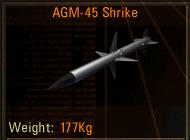
We have 1 AGM - 45 at the game...
